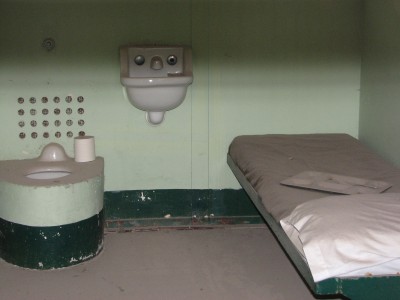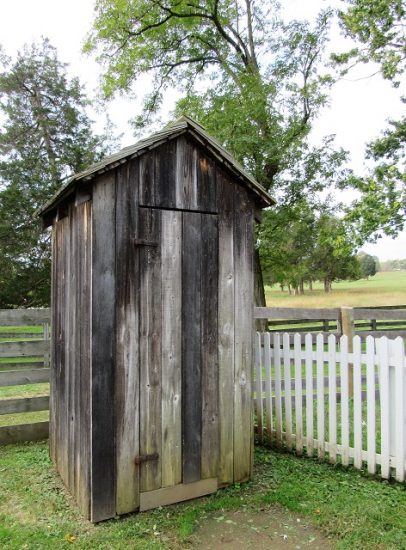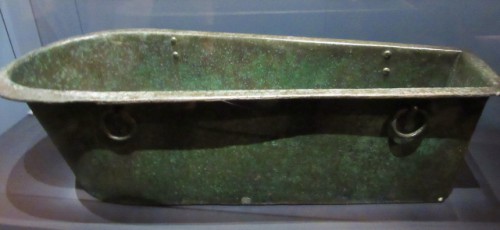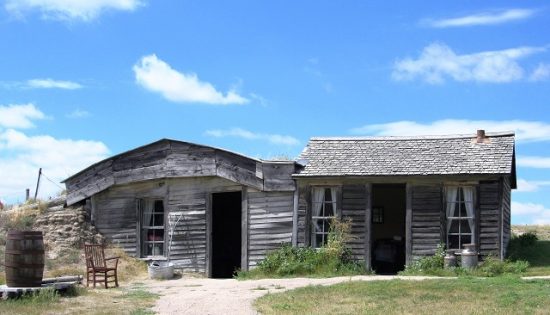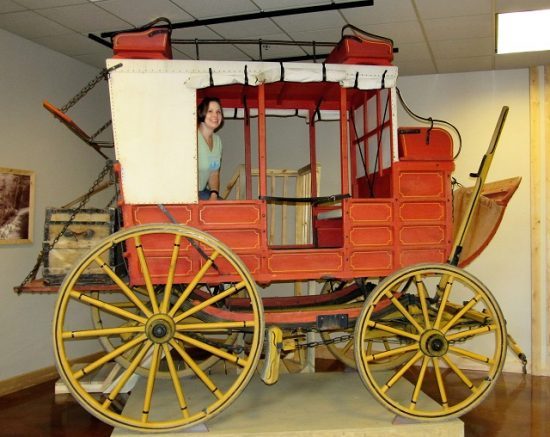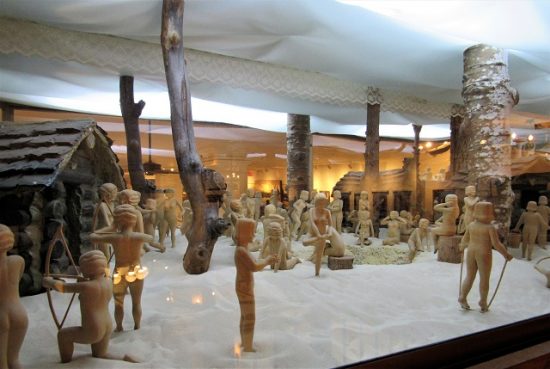Oliver likes to sleep like a person these days. Tucked up next to me, under the covers, with his head on the pillow. I don’t have the heart to tell him if he wants to be a person, he needs to put in a 40 hour work week… He really does have the life.
Archive | February 2017
Badlands National Park History
Badlands National Park is a picture of contrasts. While seemingly a harsh desolate environment made up of eroded buttes, spires and pinnacles, it also contains the largest undisturbed mixed grass prairie in the United States. A prairie that teams with life.
Badlands began as Badlands National Monument on March 4, 1929 when it was authorized by Herbert Hoover, although it wasn’t established until January 25, 1939 (Franklin Roosevelt was President by then). It was re-designated as a National Park on November 10, 1978. The park protects 242,756 acres of land, of which 64,144 is designated wilderness. The park had 966,263 visitors in 2016 – my mom and I were two of them!!
The park boundaries are brimming with fossils; it actually contains the richest deposits of Oligocene mammals known. It sort of boggles the mind to imagine mammals roaming around on this land 33 million years ago, but there they were. The fossil remains in the park include camels, three-toed horses, oreodonts, antelope-like animals, rhinoceroses, deer-like mammals, rabbits, beavers, creodonts, land turtles, rodents and birds. There are also a fair number of marine animals in the fossil record here, including ammonites, nautiloids, fish, marine reptiles, and turtles.
Badlands has known human habitation for approximately 11,000 years. The paleo-Indians, although little studied, are the inhabitants who arrived after crossing the ice bridge from Eurasia in the late Pleistocene period (“i” before “e” except after “c”, or in Pleistocene, apparently…). Stone tools, including projectile points, have been found in the area, as well as charcoal from ancient campfires. Later came the Arikara, and then the Lakota, who used the elevation of the Badlands Wall to scout for herds for hunting, as well as approaching enemies.
At the end of the 19th century, homesteaders and gold miners moved into the nearby area, and the U.S. government forced the tribes onto reservations, including one called the Pine Ridge Indian Reservation. Many of the Oglala Sioux in the area fought the orders to move to reservations, and instead chose to defy the order, following the prophet Wovoka. From this movement, the Ghost Dance was born. The Sioux believed that the Ghost Dance would restore their land and force the white settlers and government agents to leave, and that the Ghost Shirts that they wore would be impervious to bullets. Well… This didn’t end up panning out, and sadly the ghost dancers, being pursued by government troops in 1890, ended up seeking refuge on the Pine Ridge Reservation.
Gunfire erupted as the soldiers were attempting to disarm the group – as the story goes a deaf man named Black Coyote was reluctant to give up his rifle, since he had paid a lot for it. On December 29, 1890, what became known as the Wounded Knee Massacre killed over 300 Native Americans and 30 soldiers. It was the last big clash between Plains Indians and U.S. troops in the series of clashes that became known as the Indian Wars. The Pine Ridge Reservation now contains the Stronghold Unit and the Pine Creek Unit of Badlands National Park within its boundaries. Although the site of the Wounded Knee Massacre is not within the boundaries of the park, it is nearby and open to the public.
Badlands has lots to do – there are hikes of all levels, from a 0.25 mile flat traverse over a raised boardwalk to a 10 mile back-country hike. The trails range from easy to strenous, but you do need to plan accordingly for extreme temperatures and weather (both in summer and winter). You can back-country camp, cycle on the roads (paved, dirt or gravel), and there is a night sky program. Wildlife viewing is also popular at the park, with prairie dogs, bison, deer, pronghorn, Rocky Mountain bighorn sheep, badgers, coyotes, bobcats, and black-footed ferrets being just some of the species found in the park. 67 species of birds are known to nest within the park and over 200 species have been documented there. There are also reptiles, amphibians and butterflies present there.
I have been excited about visiting this park for a long time, and I was finally going to be able to visit! Posts coming soon!
Toilets of Yesteryear…
Apparently my readers are all as strange as I am, and are clamoring for a post on the historic toilets of the United States. Or, at least the ones I have come across in my travels. So… Without further ado… Don’t try to pretend later that you didn’t ask for it… Weirdos… 🙂
Alcatraz has a few different kinds of historic toilets. The general population toilet…
And a slightly more recognizable toilet – in the cell where John Anglin managed to dig out of Alcatraz in 1962. Perhaps he made sure to go potty one last time before he escaped, never to be heard from again…

The Cell that John Anglin Dug Out of in 1962. He Made it Off the Island, But Was Never Heard From Again, and Presumed Drowned.
This prison toilet at the Old Idaho Penitentiary was slightly less fancy than the toilets at Alcatraz… I wonder if pooping in a bucket helped the recidivism rates.

See that panel in the wall there? That’s where prisoners got to keep their shared bucket. Yep – you got to poop in a bucket, and you probably had to empty it out and wash it yourself. Imagine the aroma on a 90+ degree day…
I visited Fort Vancouver with my mom and my cousin and checked out this historic double outhouse (although it is a replica). Posing optional…
This privy at George Washington’s Mount Vernon is probably original, given that it looks like they are trying to restore it. That’s my story and I am sticking to it.

A historic privy at Mount Vernon. Sadly, the privy is not discussed in the guidebook, so I can’t tell you when it was built, or if it is original.
This outhouse at the Wilmer McLean House at Appomattox Court House National Historical Park is almost certainly a replica, but it sure looks the part.
This historic outhouse was discovered in the ghost town of St. Elmo, Colorado. It looks a little rickety – step on in and try it out!
While this toilet is not historic, it made the blog purely for its “technological advancements.” Given that it is located in the ladies room at the Dark Horse Brewery in Marshall, Michigan, it seemed worth a mention.
This toilet at the George Washington Birthplace National Monument isn’t historic either, but I felt I had to include it for the unique foot pedal flush!
And although this isn’t a toilet, this bathtub is truly the most historic one I have ever seen. Discovered at Pompeii.
And of course, those of you who couldn’t wait for the historic toilets post will remember these recent photos from my West trip…
The Prairie Homestead’s double holed outhouse…
And a genuine nuclear missile Launch Control Center toilet.
That’s it for now folks. I am sure I have more historic toilets in my photo files, so when I come across some more, I will be sure to post another round. Maybe Toilets of Yesteryear will become a series!
Pool Time
I was going through some photos I had transferred from my old phone to my computer, and came across this gem from my trip to San Diego last April. The special effects in the photo are due entirely to the fact that my old phone was haunted. Yep, my old phone camera was extremely simple, and had no reverse color special feature that I could ever find. Yet it would randomly take photos like this, which I actually thought turned out very cool…

Would you swim in water that color?
It also made me think that I am in dire need of a vacation. Someplace warm, where I can sun myself by the pool. Soon…
At least it is the weekend!
West 2016: Missiles and Sod…
Day 4: August 8, 2016
We began our day with a trip to the Minuteman Missile National Historic Site in Philip, South Dakota. It was on the way to Badlands National Park, which was our ultimate destination for the day.
We didn’t actually tour the Launch Control Center, as that is a few miles down the road and we didn’t have time with our busy agenda for the day. There are a limited number of spaces on tours each day, for a small per person fee. The Launch Control Center was active between the 1960s and the mid-1990s, when most of the nuclear missiles were deactivated. The United States during the peak of the Cold War had about 1,000 active nuclear missiles, and each control center controlled 10 missiles. So, you can do the math – this was not the only control center.
Even without going on the tour though, the Visitor’s Center was well worth the stop. Exhibits covered the length of the history of nuclear armament, from the dropping of the first atomic bombs on Hiroshima and Nagasaki, the Cold War, the tense periods with Cuba and Russia, and the eventual agreements to move toward disarming nuclear weapons around the world. Several years ago, I toured the Titan Missile Site in Sahuarita, AZ, near Tucson, so I was able to translate that experience without seeing this silo site.
When I toured the Titan site in AZ, I was amazed by the technology that existed in the construction of the silo. On my tour there, a volunteer was asked to try to open a blast door that weighed several tons. It was so well balanced and constructed that it moved very easily on its bearings.
The Minuteman Missile Visitor’s Center had a piece of the Berlin Wall that visitors could touch.
They also had a genuine missile silo toilet – a historic toilet for my collection! You know I had to get a photo of that! Sadly it was damaged (probably by other historic toilet photo collectors) so I didn’t get to pose properly for the photo. This one will have to do…
After the Minuteman site, we went just down the road to the Prairie Homestead – a South Dakota State Historic Site. There were two draws to the site – the first was the sod house, built in 1909 by the Ed Brown family. The home also had a later wooden addition; another home that was moved from its original location, and which doubled the size of the original house. It would be difficult to live in sod, which had bugs who would move through it and drop into the home (yuck), as well as the fact that sod walls make for a damp environment and tend to sag over time.
There were also several outbuildings on the site, including an outhouse, but I’m not sure if the outhouse was original or reconstructed. That didn’t stop me from getting photos of the historic toilet and its perpetual guest. There is a root cellar, and an old well. The barn has animals, including chickens and goats, which I’m sure would keep the kids busy and entertained if for some crazy reason they got bored watching the more famous four legged residents.
The other big draw of the Prairie Homestead is that they have white prairie dogs! Staff indicated that these prairie dogs are a separate species, but they aren’t. They are actually leucistic black-tailed prairie dogs, meaning they don’t have the pigment in their skin, but do have pigmented eyes, so they aren’t albino. Many species of animals have leucistic individuals, including other mammals (white lions and tigers), reptiles and birds. These prairie dogs were certainly lighter in color than others that we saw during our trip, and they didn’t have the typical black-tipped tail of other members of their species. The fact that these prairie dogs interbred among themselves causes the genetic mutation to continue.
I loved watching them, and took lots of photos of them popping out of their burrows. They are so adorably cute!
These white prairie dogs were moved to the site in partnership with the Oglala Sioux tribe, but if you aren’t interested in seeing the sod house, you can see the white prairie dogs for free just down the road from the gas station.
By the time we left the Prairie Homestead it was lunchtime, but we had so much left to do in our day!
West 2016: Deadwood – Mines and Museums
Day 3: August 7, 2016
After our busy morning in Deadwood, our next stop was the Broken Boot Gold Mine; it was named for the old, falling apart boot that was found in the mine as the current owners were getting it ready for tours. For $12 ($5 for the tour and $7 to pan for gold), we took a tour of a now defunct gold mine. Our guide was a chipper high school student, working through the summer for his family’s business. He was upbeat and fun, and although he mostly stuck to his script, he explained the inner workings of the gold mine. This particular gold mine didn’t make that much money, but it was an interesting tour. He showed us the equipment that the miners used, and explained that they had to purchase it themselves. We also got to experience the pitch black of absolute darkness in the mine, as well as the VERY dim light of the candle that the miners worked with. The conditions would have been difficult.
At the end, if you chose to add it onto your tour, you got to try your hand at panning for gold. Of course, they seed the dirt and rocks with some gold, so it was a “miracle” that both my mom and I found some! Our guide was great about showing us the technique, although I think my mom did much better at it than I did (she has done this before). We both had a lot of fun with it though!
After the Broken Boot mine tour, we checked out the Days of ’76 Museum. That’s 1876 in case you were wondering. The entire focus of the museum is to celebrate 1876, the year that Deadwood was first established after the gold rush began, as well as the Days of ’76 festival, an annual celebration. The Days of ’76 has a rodeo, a parade, and lots of people in costume. The celebration began in 1924, so it has over 90 years of history! The museum has exhibits with photos and historic saddles and costumes from the festival and rodeo. They even have a whole floor of historic carriages from days gone by, as well as other forms of transportation, including a horse drawn hearse and a beer wagon. Strangely, there was no wine wagon… Who wouldn’t want to have a wine wagon?! But they did have an exhibit showing a historic saloon.
We had gone to the Visitor’s Center to get some information at the beginning of the day and they had a passport card where you could get stamps at various places (the bus tour, the Adams Museum, The Days of ’76 Museum, the Broken Boot Mine, the Trolley, etc.). We ended up being one stamp short for the day to get the prize, but the woman took pity on us. I think she was secretly impressed that we managed to make the most of our day… Either that, or she just didn’t care… But either way it worked out well for us because, we each got to redeem our passports and we both chose the historic photo playing cards… Yes, in case you are wondering, I am a complete and total nerd. So?
We left Deadwood and made our way to our home for the next three nights; the Mystic Valley Inn in Custer, South Dakota. Along the way we got caught in a huge rainstorm which sent bikers trying to find places to shelter along the side of the highway. They looked pretty miserable standing out there in the rain; it made me pretty happy for our wonderful, yet dented to hell, car. The rain had cleared along the way though, and when we got to our motel, it had stopped. We got checked in to the cute 40’s/50’s roadside motel with a nice arbor and outside seating area, and then ventured out again to find dinner…
The Buglin’ Bull Bar and Grill in Custer, South Dakota looked intriguing, so we got a table and ordered our meals. I had the beer sampler (The Wapiti Wheat, the 1874 Black Hills Gold (an Amber), the Armstrong Ale (an ESB), and the Custer Nut Brown Ale) – they were all good, but less complex than the Washington beers I have gotten used to. For dinner I had the Pheasant Flatbread with kalamata olives, peperoncinis, feta cheese and tomato. The pheasant tasted like chicken, but more oily and gamey. It was delicious!
We ended the evening relaxing in our room, watching a bit of TV, journaling and reading. The perfect end to a great day!
Distance for the Day: Belle Fourche, SD – Deadwood, SD – Custer, SD (1 hr, 49 min, 84 miles)
Hotel for the night: Mystic Valley Inn – Custer, SD
West 2016: Deadwood – Wild Bill and Bikers!
Day 3: August 7, 2016
Our destination for the third day of our trip was Deadwood, South Dakota, famous for its origins as a Gold Rush town. Gold and silver were found here in 1874 and triggered the beginning of the Black Hills Gold Rush. George Armstrong Custer was responsible for making the announcement that brought tens of thousands of eager miners to the area, completely unconcerned about violating the 1868 Treaty of Fort Laramie, which had given ownership of the Black Hills to the Lakota people. But white men wanted money, so who cares about the government’s silly little commitment to the Native Americans who called this land home… Despite the land dispute reaching the United States Supreme Court, the Lakota were not successful at preventing the encroachment of the miners on their land.
Deadwood is also well known as the town where Wild Bill Hickok lived and met his untimely end by a bullet in the head, while he was sitting in a chair playing poker in the #10 saloon. He was 39 years old. Wild Bill Hickok was known for being an outlaw as well as a lawman over his relatively short life. Less well known is that he also worked as a teamster and a scout during the Civil War and it is rumored that he was a Union spy in Confederate territory. But my personal favorite tidbit about him was that he was mauled by a bear and lived!
The first order of business for our day in Deadwood was a bus tour of town, by Boothill Tours. My mom and I were joined by about 10 people who were around for the Sturgis Rally; we were the only ones who weren’t. Our guide told us stories of Wild Bill Hickok and Calamity Jane, and attempted to separate the myth from the likely truth. Hickok was married to an older woman, and beyond being in Deadwood at the same time as the much younger Calamity Jane, they were unlikely to have been in a relationship together. Our tour took us around town, showing us the historic buildings of town, pointing out the Adams House Museum from the outside, Mount Moriah cemetery, and a home whose roof was made from large can lids. We all got out of the bus at Mount Moriah Cemetery to hear additional stories about Wild Bill Hickok and Calamity Jane, to see their graves, and to view the town below from the cemetery’s vantage point above the hill.
Our tour guide was fantastic, telling us the history of the town and its residents, explaining the disasters that have befallen Deadwood over the years. It has suffered floods and multiple fires, and has had to reinvent itself over the years, after the gold rush ended, and it became just one more dying town… After our bus tour, it was mid-morning, and Deadwood was really starting to fill up with Sturgis bikers who were out touristing. The town was packed with bikers and bikes!
We toured the Adams Historical Museum and checked out the exhibits; it was an interesting hodge podge of stuff! The museum had an antique narrow gauge steam engine, a collection of small carved wood statues of nudists, comprising an entire wooden nudist colony, Wild Bill Hickok paraphernalia, an exhibit detailing the prostitution industry, and an exhibit with all sorts of opium den artifacts. They also displayed Potato Creek Johnny’s famous gold nugget (another cast member of local color in Deadwood), dinosaur fossils, and a very nice N.C. Wyeth drawing of Wild Bill Hickok. They even had a two headed calf! I enjoyed the museum, which is housed in a historic building downtown.
After the Adams Museum, we went to lunch at the Tin Lizzie, a buffet restaurant inside a casino. It was fine but certainly nothing special.
We wandered along Main Street, heading into Saloon #10, where Wild Bill Hickok was murdered by Jack McCall, the day after beating McCall out of a large sum of money in poker. McCall rode away after the shooting, but fell off his horse and was caught a few blocks away. We poked around in a few shops and checked out motorcycles of all sizes, shapes and colors. As well as bikers of all sizes, shapes and colors… I don’t think I have ever seen so many bikers; there had to be thousands there in town – cruising the streets, sitting at restaurants and bars, walking along the sidewalks like we were – and we weren’t even in Sturgis!
We had already seen so much, and our day in Deadwood was only half over!
Oliver’s Tumor
A week ago, Oliver had surgery to remove a fibrosarcoma from the space just behind his right shoulder blade. Cancer. Luckily, I noticed it when it was small, and took him in to have it checked out.
The surgery was invasive, but went well. They had to cut out the tumor, along with pieces of three different muscles. A cube about 2 inches on each side. And then they sewed the muscles back together so he wouldn’t lose use in his shoulder and right front leg.
He looks a bit like Frankenstein, but has tolerated the recovery process well. He is leaving his incision alone, and it is staying closed. He is able to move around as he needs to, walking and running and jumping up on the bed by himself. He only seems to favor that leg while going downstairs.
He will need regular massages in the future to make sure the tumor doesn’t grow back (I should have such a prescription!).
I am glad things went ok, as it was certainly stressful leading up to the surgery! I worry about the furkids, and always hope that they live forever. It looks like there’s still a chance with Oliver. 🙂
Happy weekend everybody!


